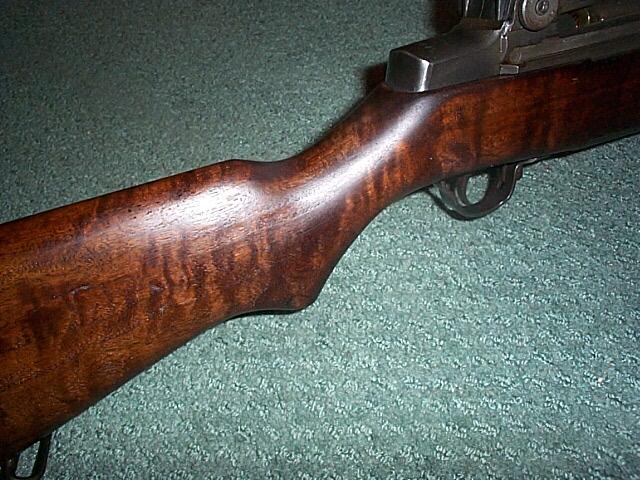-
FREE MEMBER
NO Posting or PM's Allowed

WW2 gun - how to clean
I bought a Field Grade in quite good condition on Friday (SA 2599565, Feb 1944), which I hope to repopulate with other parts correct to the year. The stock is very dirty, however, and the entire gun could use a good cleaning. I know there are different opinions about cleaning versus removing patina.
Is there a common consensus over how far to go in cleaning (esp. wood) before you start removing value from the rifle from a collecting point of view?
-Scott
Information
 |
Warning: This is a relatively older thread
This discussion is older than 360 days. Some information contained in it may no longer be current. |
|
-
09-20-2009 04:11 PM
# ADS
Friends and Sponsors

-
FREE MEMBER
NO Posting or PM's Allowed

That wasn't you bidding against me on Gun Broker on that operating rod was it? 
I used this method to clean up my stock. It worked very well. It isn't perfect but it is far better than when I received it. This is the advice of Cabinetman over on another forum.
Once you've received a new beauty, a total disassembly, inspection, and general cleaning should be undertaken. I, personally, would never, ever shoot ANY new rifle I owned without a teardown. There's too much at stake. Once the metal has been cleared then a stock inspection is next. Since your rifles both have a finish remaining on them from what I see in the photos, a general cleaning might be in order. This is not to alter what's the stock looks like other than to simply remove a lot of accumulated grunge on the surface. While the car collector might never want to replace the old paint, he most certainly would not drive it around filthy. Same goes here. Begin with a surface wash of a solvent: either acetone or lacquer thinner. Neither one will affect the original finish on that stock but they will both cut through any petroleum based debris on the surface and in the grooves. Use a towel rag and, with appropriate pressure, bath the stocks (usually outside) until all the debris has been removed. Set the stock aside for about 20 minutes and let all the solvent evaporate. ( BTW I don't ever recommend mineral spirits. It's much too oily and doesn't cut debris away any where near as effectivel as lacquer thinner or acetone.)
Next, grab some Fantastic or 409 or some other water-based cleaner. Spray enough onto a clean towel rag to make it wet and once again attack the stock with it. This cleaner will remove any water-based debris that the solvent based material would not touch. Even after copious cleaning with solvents, you'll be surprised how much more grunge you'll get off. Again, this technique will NOT harm the original finish. Also, notice I said spray only the cloth, not the wood. That will keep the amount of water off the stock. The results will make this stock a bit lighter in color since the dirt has been removed. No problem. One other thing, however, and that's to inspect it carefully for any growing cracks or splits at this time. It'll be easier to see them. Gently but deliberately bend and twist the stock in your hand and watch for any cracks or splits that might appear under stress. If there are any, poke around the essays at the top of this forum for some guidance.
Now, after all that you reoil the stock. Find some
BLO
(boiled
linseed oil
) or some Tung Oil Finish. Rub the stock with it allowing it to sit wet under the oil for about 15 minutes. Then wipe the stock down and let it sit overnight. That will allow the oil to cure. Next day, wipe it again the same way. Since there's a finish on the stock all the new oil will do is provide another thin protective layer onto the cleaned surface and provide some protection to any areas that might not have an intact finish on it.
Voila! Nothing more needs to be done on either of those rifle. Reassemble after some oiling of your metal bits and you'll be good to go for a year. Once per year I recommend a wipedown of a cloth with some oil. You'll keep ahead of the shooting debris from the previous year and clean it at the same time!
-
FREE MEMBER
NO Posting or PM's Allowed

No, haven't tried to buy any Garand stuff on GB yet. Good information on the stock cleaning, but doesn't cover things like steaming out dents, etc. and the pros and cons versus keeping the patina and history.
stuff on GB yet. Good information on the stock cleaning, but doesn't cover things like steaming out dents, etc. and the pros and cons versus keeping the patina and history.
-Scott
-
Legacy Member

NOTHING you do
will change the value in a hegative way (it's not really a "collectible" gun or stock or you would not have been able to buy it as a field grade from CMP ).
).
You can do anything you like from a simple Murphys Oil furniture "soap" to stripping it completely with Blue ZIp Strip (or oven cleaner) and refinishing it. Little hint, typical ugly greasy dirty CMP stocks aint collectible, unless they have a nice crisp original WW2 cartouche on em, etc. Do yourself a favor, don't worry about ANYTHING you do or don't do to that wood. Honestly, would you rather have the crappy looking "field/rack grade" wood in the first picture, or the exact same stock and handguards "cleaned" up (with oven cleaner no less) stock in the picture at bottom?
Oh, "patina" is usually a synonym for dirt and/or grease. If so, again, fa-get-about-it.
as for steaming out dents, the ONLY way to do this (where it works) will for SURE result in stripping the wood of finish anyway.


Last edited by AKA Hugh Uno; 09-20-2009 at 07:46 PM.
-
Thank You to AKA Hugh Uno For This Useful Post:
-
FREE MEMBER
NO Posting or PM's Allowed


Originally Posted by
AKA Hugh Uno

will change the value in a hegative way (it's not really a "collectible" gun or stock or you would not have been able to buy it as a field grade from
CMP
).
You can do anything you like from a simple Murphys Oil furniture "soap" to stripping it completely with Blue ZIp Strip (or oven cleaner) and refinishing it. Little hint, typical ugly greasy dirty CMP stocks aint collectible, unless they have a nice crisp original WW2 cartouche on em, etc. Do yourself a favor, don't worry about ANYTHING you do or don't do to that wood. Honestly, would you rather have the crappy looking "field/rack grade" wood in the first picture, or the exact same stock and handguards "cleaned" up (with oven cleaner no less) stock in the picture at bottom?
Oh, "patina" is usually a synonym for dirt and/or grease. If so, again, fa-get-about-it.
as for steaming out dents, the ONLY way to do this (where it works) will for SURE result in stripping the wood of finish anyway.
+1 















 Register To Reply
Register To Reply













